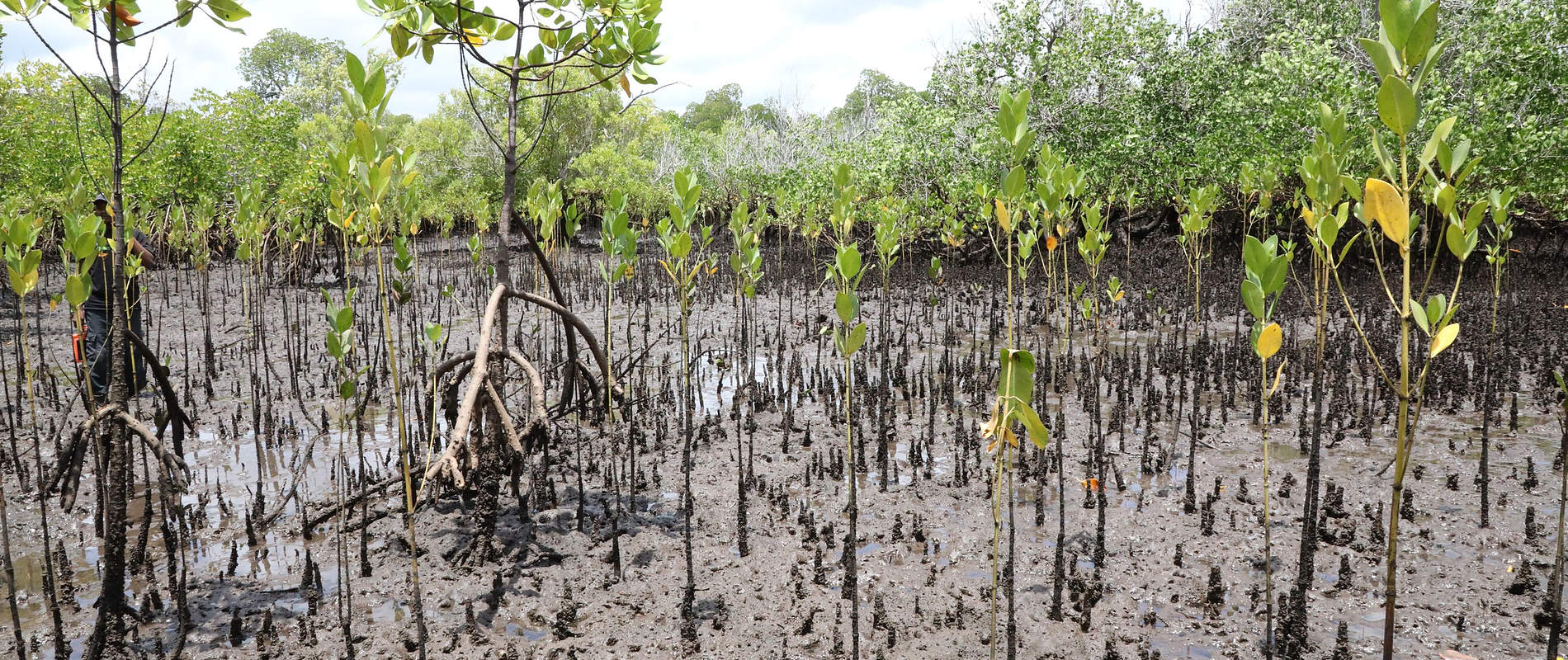11.8 million new trees in one threatened ecosystem. It’s a staggering feat — particularly in the context of a two-year timeframe.

And yet, that is exactly what our tree-planting partners in Lamu County, Eden Reforestation Projects (ERP) and Lamu Conservation Trust (LCT), have achieved. Under the leadership of ERP, they have planted an astounding 11,809,418 trees in Lamu since July 2020 — and their work is just getting started. This initiative has created 76 full-time jobs for the local community, along with dozens of seasonal opportunities for workers who collect seeds and plant the terrestrial trees in the rainy season.
Located on the north coast of Kenya, Amu is home to one of the largest mangrove forests in the world and some of the oldest coastal forests in Africa. It is an important habitat for all manner of creatures, from small herds of elephants to large populations of reticulated giraffe, Cape buffalo, topi, and eland. Some of the most genetically diverse lions in East Africa can be found in Amu, ranging from the typically maneless Tsavo lions to the unique blue-eyed Somali lions.

As one of the last coastal frontiers in Kenya, Amu hasn’t been densely settled by people. And yet, this fragile environment is under threat. In recent years, it has struggled with illegal encroachment, deforestation, poaching and unsustainable agriculture. Age-old forests have been lost and wild habitats fragmented, posing an urgent threat to the wider ecosystem.
In order to preserve this habitat, we have long supported LCT, a community-based group providing a permanent presence on the ground in Lamu. More recently, we embarked on an ambitious tree-planting project in Amu, with the goal to regenerate its coastal mangrove forests. By partnering with ERP, we are able to capitalise on economies of scale: EPR plants tens of millions of trees in Africa every month, which brings cost-effectiveness and vital expertise to the project.

Our first tree plantings took place in 2020 in Lamu’s Milihoi Channel, which extends into Amu Ranch. In those early days, we explored the channels by air, boat, and foot, scouting out potential planting sites and assessing the potential for a large-scale restoration effort. ERP employed an amazing group who had formed a ‘beach management’ volunteer unit in an attempt to protect their local mangrove forest. They had sought assistance from the SWT in the past to support their patrol efforts, so it seemed only fitting that we were able to offer them this opportunity.
Thus began an extremely productive reforestation initiative that has stretched more than two years. The SWT has directly funded the planting of 760,000 trees, 540,000 of which have already been planted. Most of these seeds are mangroves, which line the many channels that snake through the Lamu archipelago and mainland. Given that a single mangrove can live for upwards of a century, each seed planting represents a significant investment in the future.

The mangrove reforestation is helping to restore thousands of acres of degraded habitats for marine, insect, and bird life that were lost due to illegal logging, charcoal burning, and heavy flooding during the 2008 el Nino event. The most difficult areas to reforest are those that had been clear-felled, eroding the nutritious mud in which mangroves thrive and leaving inhospitable sand in its wake. For these areas, a unique ‘caregiver’ strategy is employed, where mangroves are planted in thin bands along the edges of remnant forest so they are afforded a small amount of shade and protection from established trees. Each year, another concentric band is planted adjacent to the last, allowing for a much higher survival rate than trying to plant the entire deforested area at once.
Trees that were planted last year through a generous donation from the Perfect World Foundation have thrived. With a relatively high survival rate of 90 percent, the saplings have reached almost 2 metres in height. They are well on their way to becoming mature trees that will provide many millions of new propagules to spread naturally in the Lamu channels and beyond.

We have also worked with ERP to expand our existing tree nursery on Amu Ranch to a capacity of 260,000 trees per annum, which are being planted on Amu Ranch in strategic areas. We have faced several challenges getting started, including security concerns and a multi-year drought, but activities in the nursery are ramping up. The recent construction of a large water reservoir that holds millions of litres of rainwater will sustain the tree nursery through the drier months.
Kenya’s mangroves are a national treasure. They are biodiversity hotspots, home to an incredible array of species. Their sinewy roots and branches provide breeding habitats for fish and shellfish, migratory birds and even sea turtles. Mangroves are also the first line of defence for coastal communities, stabilising shorelines by slowing erosion and providing natural barriers to protect against flooding. Given that fishing is at the heart of Lamu County, our ability to preserve this habitat benefits wildlife and the people who live alongside them. With the ability to store three times the carbon of an equivalent area of tropical rainforest, mangroves are also essential in the fight against climate change.

Today’s seedlings are tomorrow’s habitats, carbon storers, coastal protectors, and natural wonders. Thanks to ERP’s achievement, more than 11.8 million new trees are now in Amu, establishing roots that, with luck, will continue to flourish for the next century.
